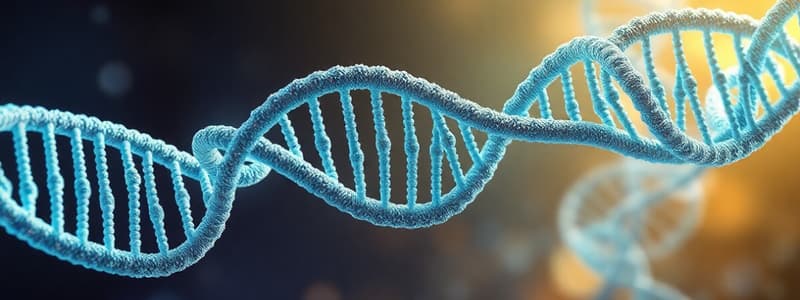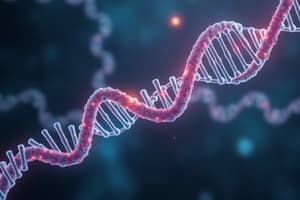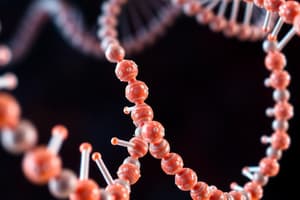Podcast
Questions and Answers
What is the primary challenge in analyzing the chemical compound discussed?
What is the primary challenge in analyzing the chemical compound discussed?
- The structure of the compound is not represented correctly.
- The compound's properties are overly complex to interpret.
- There are no descriptions of the chemical compound available.
- The low-resolution image does not provide complete details. (correct)
In the context provided, which of the following is likely absent due to the image quality?
In the context provided, which of the following is likely absent due to the image quality?
- A list of possible applications of the compound.
- A comparison with other similar compounds.
- A high-quality diagram of the compound's structure. (correct)
- A detailed analysis of the compound's chemical reactions.
What type of document does the image seem to originate from?
What type of document does the image seem to originate from?
- A presentation summarizing recent chemical findings.
- A textbook or study guide discussing chemical compounds. (correct)
- A government report on chemical safety regulations.
- A research paper with experimental results.
Which of the following might be necessary to improve the analysis of the discussed compound?
Which of the following might be necessary to improve the analysis of the discussed compound?
What aspect of the chemical compound is likely discussed in the source material?
What aspect of the chemical compound is likely discussed in the source material?
Which of the following statements about nucleotides is true?
Which of the following statements about nucleotides is true?
What key characteristic differentiates RNA from DNA?
What key characteristic differentiates RNA from DNA?
What term was originally used to refer to nucleic acids before it was renamed?
What term was originally used to refer to nucleic acids before it was renamed?
Which of the following correctly describes the structure of nucleic acids?
Which of the following correctly describes the structure of nucleic acids?
What is the primary function of messenger RNA (mRNA) in cells?
What is the primary function of messenger RNA (mRNA) in cells?
Which substances are nucleic acids NOT classified as?
Which substances are nucleic acids NOT classified as?
Which statement regarding ribosomal RNA (rRNA) is true?
Which statement regarding ribosomal RNA (rRNA) is true?
What characteristic is unique to transfer RNA (tRNA)?
What characteristic is unique to transfer RNA (tRNA)?
Which of the following characteristics does NOT describe RNA?
Which of the following characteristics does NOT describe RNA?
How long is the typical messenger RNA (mRNA) for a specific protein?
How long is the typical messenger RNA (mRNA) for a specific protein?
What significant feature of the scanning tunneling microscope (STM) allows it to view the surface of solids?
What significant feature of the scanning tunneling microscope (STM) allows it to view the surface of solids?
Which component of tRNA is responsible for recognizing the codon in mRNA during protein synthesis?
Which component of tRNA is responsible for recognizing the codon in mRNA during protein synthesis?
Which of the following statements about the tRNA molecule is NOT correct?
Which of the following statements about the tRNA molecule is NOT correct?
In the context of molecular biology, which process is NOT directly involved with tRNA?
In the context of molecular biology, which process is NOT directly involved with tRNA?
What accomplishment did Gerd Binnig and Heinrich Rohrer achieve in relation to the scanning tunneling microscope?
What accomplishment did Gerd Binnig and Heinrich Rohrer achieve in relation to the scanning tunneling microscope?
Which diagram type included in the document provides insight into the structural properties of RNA molecules?
Which diagram type included in the document provides insight into the structural properties of RNA molecules?
How many different kinds of tRNA are typically found in human cells?
How many different kinds of tRNA are typically found in human cells?
What is a unique feature of the 3' end of the tRNA molecule?
What is a unique feature of the 3' end of the tRNA molecule?
Which statement about acylglycerols is correct?
Which statement about acylglycerols is correct?
What distinguishes phospholipids from acylglycerols?
What distinguishes phospholipids from acylglycerols?
Which of the following roles do terpenes NOT fulfill?
Which of the following roles do terpenes NOT fulfill?
Waxes are primarily known for which of the following functions?
Waxes are primarily known for which of the following functions?
Which statement about the structure of acylglycerols is incorrect?
Which statement about the structure of acylglycerols is incorrect?
What is the significance of Chargaff's rule in understanding DNA structure?
What is the significance of Chargaff's rule in understanding DNA structure?
How do the two polynucleotide chains in the DNA double helix orient in relation to each other?
How do the two polynucleotide chains in the DNA double helix orient in relation to each other?
What was a major contribution of Rosalind Franklin and Maurice Wilkins to the understanding of DNA?
What was a major contribution of Rosalind Franklin and Maurice Wilkins to the understanding of DNA?
Which base pairs are held together by hydrogen bonds in a DNA molecule?
Which base pairs are held together by hydrogen bonds in a DNA molecule?
What is the approximate length of each turn of the DNA double helix?
What is the approximate length of each turn of the DNA double helix?
What primary function does DNA serve in living organisms?
What primary function does DNA serve in living organisms?
What is the primary role of collagen in the body?
What is the primary role of collagen in the body?
Which protein type is primarily involved in speeding up biochemical reactions?
Which protein type is primarily involved in speeding up biochemical reactions?
What characteristic describes the width of the DNA double helix?
What characteristic describes the width of the DNA double helix?
Which of the following statements accurately describes the strands of DNA?
Which of the following statements accurately describes the strands of DNA?
Which of the following statements correctly describes the role of antibodies?
Which of the following statements correctly describes the role of antibodies?
Which type of protein is histone primarily associated with?
Which type of protein is histone primarily associated with?
What is the function of haemoglobin in the bloodstream?
What is the function of haemoglobin in the bloodstream?
Which statement accurately describes saturated fatty acids?
Which statement accurately describes saturated fatty acids?
Which fatty acid is notable for having 16 carbon atoms in its structure?
Which fatty acid is notable for having 16 carbon atoms in its structure?
Which of the following statements is true regarding waxes?
Which of the following statements is true regarding waxes?
What characteristic distinguishes unsaturated fatty acids from saturated ones?
What characteristic distinguishes unsaturated fatty acids from saturated ones?
Which of the following is NOT a typical source of a saturated fatty acid?
Which of the following is NOT a typical source of a saturated fatty acid?
What is a characteristic property of acyl glycerols in relation to water?
What is a characteristic property of acyl glycerols in relation to water?
Which process do saturated long-chain fatty acid acyl glycerols undergo at a higher temperature compared to unsaturated short-chain fatty acid acyl glycerols?
Which process do saturated long-chain fatty acid acyl glycerols undergo at a higher temperature compared to unsaturated short-chain fatty acid acyl glycerols?
Which of the following roles do phospholipids NOT perform?
Which of the following roles do phospholipids NOT perform?
What is a primary consequence of high levels of acyl glycerols in the body?
What is a primary consequence of high levels of acyl glycerols in the body?
Which of the following accurately describes the structure of phospholipids?
Which of the following accurately describes the structure of phospholipids?
What type of compounds are terpenes primarily recognized for?
What type of compounds are terpenes primarily recognized for?
Which property is NOT associated with acyl glycerols?
Which property is NOT associated with acyl glycerols?
What role do waxes primarily serve in certain applications?
What role do waxes primarily serve in certain applications?
What is an effect of hydrogenation on acyl glycerols?
What is an effect of hydrogenation on acyl glycerols?
What is the primary composition of lipids, including acyl glycerols?
What is the primary composition of lipids, including acyl glycerols?
Which type of protein is characterized by requiring a secondary structure and being insoluble in water?
Which type of protein is characterized by requiring a secondary structure and being insoluble in water?
What is the primary consequence of a mutation that alters the amino acid sequence in hemoglobin?
What is the primary consequence of a mutation that alters the amino acid sequence in hemoglobin?
Which of the following proteins functions primarily in bodily defense?
Which of the following proteins functions primarily in bodily defense?
Sickle cell disease results from which specific type of genetic alteration?
Sickle cell disease results from which specific type of genetic alteration?
Which of the following statements about globular proteins is correct?
Which of the following statements about globular proteins is correct?
Which protein is primarily involved in muscle contraction?
Which protein is primarily involved in muscle contraction?
What primary feature differentiates fibrinogen from other fibrous proteins?
What primary feature differentiates fibrinogen from other fibrous proteins?
Which of the following is NOT a consequence of errors in the amino acid sequence of proteins?
Which of the following is NOT a consequence of errors in the amino acid sequence of proteins?
Which amino acid change specifically causes the sickle shape in red blood cells?
Which amino acid change specifically causes the sickle shape in red blood cells?
Collagen is primarily classified as which type of protein based on its structure?
Collagen is primarily classified as which type of protein based on its structure?
Flashcards
Messenger RNA (mRNA)
Messenger RNA (mRNA)
A single-stranded molecule that carries genetic information from DNA in the nucleus to ribosomes in the cytoplasm.
Ribosomal RNA (rRNA)
Ribosomal RNA (rRNA)
A crucial component of ribosomes, essential for protein synthesis.
Transfer RNA (tRNA)
Transfer RNA (tRNA)
A small RNA molecule that transfers specific amino acids to ribosomes during protein synthesis.
RNA (Ribonucleic Acid)
RNA (Ribonucleic Acid)
Signup and view all the flashcards
Codon
Codon
Signup and view all the flashcards
Chemical Compound
Chemical Compound
Signup and view all the flashcards
Molecular Structure
Molecular Structure
Signup and view all the flashcards
Properties of a Compound
Properties of a Compound
Signup and view all the flashcards
Compound Behavior
Compound Behavior
Signup and view all the flashcards
Chemistry
Chemistry
Signup and view all the flashcards
Nucleic Acids
Nucleic Acids
Signup and view all the flashcards
Nucleotide
Nucleotide
Signup and view all the flashcards
Deoxyribose
Deoxyribose
Signup and view all the flashcards
Ribose
Ribose
Signup and view all the flashcards
Phosphoric Acid
Phosphoric Acid
Signup and view all the flashcards
What is the structure of DNA?
What is the structure of DNA?
Signup and view all the flashcards
How are the DNA strands organized?
How are the DNA strands organized?
Signup and view all the flashcards
How do the bases in DNA pair?
How do the bases in DNA pair?
Signup and view all the flashcards
What holds the DNA strands together?
What holds the DNA strands together?
Signup and view all the flashcards
How wide is the DNA helix?
How wide is the DNA helix?
Signup and view all the flashcards
How long is one complete turn of the DNA helix?
How long is one complete turn of the DNA helix?
Signup and view all the flashcards
What is Chargaff's rule?
What is Chargaff's rule?
Signup and view all the flashcards
How was the DNA double helix structure discovered?
How was the DNA double helix structure discovered?
Signup and view all the flashcards
What is a Scanning Tunneling Microscope (STM)?
What is a Scanning Tunneling Microscope (STM)?
Signup and view all the flashcards
What is the resolution of an STM?
What is the resolution of an STM?
Signup and view all the flashcards
How does an STM work?
How does an STM work?
Signup and view all the flashcards
What is transfer RNA (tRNA)?
What is transfer RNA (tRNA)?
Signup and view all the flashcards
What is a codon?
What is a codon?
Signup and view all the flashcards
How does tRNA participate in protein synthesis?
How does tRNA participate in protein synthesis?
Signup and view all the flashcards
What is ribosomal RNA (rRNA)?
What is ribosomal RNA (rRNA)?
Signup and view all the flashcards
What is the Central Dogma of Molecular Biology?
What is the Central Dogma of Molecular Biology?
Signup and view all the flashcards
Phospholipid
Phospholipid
Signup and view all the flashcards
Acylglycerol
Acylglycerol
Signup and view all the flashcards
Terpene
Terpene
Signup and view all the flashcards
Triacylglycerol (Triglyceride)
Triacylglycerol (Triglyceride)
Signup and view all the flashcards
Waxes
Waxes
Signup and view all the flashcards
Saturated Fatty Acids
Saturated Fatty Acids
Signup and view all the flashcards
Unsaturated Fatty Acids
Unsaturated Fatty Acids
Signup and view all the flashcards
Beeswax
Beeswax
Signup and view all the flashcards
Cutin
Cutin
Signup and view all the flashcards
Structural Proteins
Structural Proteins
Signup and view all the flashcards
Functional Proteins
Functional Proteins
Signup and view all the flashcards
Collagen
Collagen
Signup and view all the flashcards
Elastin
Elastin
Signup and view all the flashcards
Keratin
Keratin
Signup and view all the flashcards
Fibrous Proteins
Fibrous Proteins
Signup and view all the flashcards
Globular Proteins
Globular Proteins
Signup and view all the flashcards
Amino Acid Sequence
Amino Acid Sequence
Signup and view all the flashcards
Sickle Cell Anemia
Sickle Cell Anemia
Signup and view all the flashcards
Hemoglobin
Hemoglobin
Signup and view all the flashcards
Point Mutation
Point Mutation
Signup and view all the flashcards
Enzymes
Enzymes
Signup and view all the flashcards
Hormones
Hormones
Signup and view all the flashcards
Antibodies
Antibodies
Signup and view all the flashcards
What are lipids?
What are lipids?
Signup and view all the flashcards
What are Acyl Glycerols?
What are Acyl Glycerols?
Signup and view all the flashcards
What are the key properties of Acyl Glycerols?
What are the key properties of Acyl Glycerols?
Signup and view all the flashcards
What are the key roles of Acyl Glycerols?
What are the key roles of Acyl Glycerols?
Signup and view all the flashcards
What are Phospholipids?
What are Phospholipids?
Signup and view all the flashcards
What are the key functions of Phospholipids?
What are the key functions of Phospholipids?
Signup and view all the flashcards
What are Terpenes?
What are Terpenes?
Signup and view all the flashcards
What are Waxes?
What are Waxes?
Signup and view all the flashcards
How can Acyl glycerols be related to diseases?
How can Acyl glycerols be related to diseases?
Signup and view all the flashcards
What is the difference between margarine and butter?
What is the difference between margarine and butter?
Signup and view all the flashcards
Study Notes
RNA Structure and Function
- RNA is a single-stranded nucleic acid
- RNA is a polymer of nucleotides
- RNA contains ribose sugar, a phosphate group, and a nitrogenous base
- RNA's structure has three loops, and an anticodon
- Three types of RNA: messenger RNA (mRNA), transfer RNA (tRNA), and ribosomal RNA (rRNA)
- mRNA carries genetic information from DNA in the nucleus to the ribosome in the cytoplasm.
- tRNA carries specific amino acids to the ribosome during protein synthesis
- rRNA forms the ribosome, the site of protein synthesis.
- RNA differs from DNA in having uracil instead of thymine.
Central Dogma of Life
- The central dogma describes the flow of genetic information: DNA→RNA→protein.
- DNA makes RNA in a process called transcription.
- RNA makes proteins in a process called translation.
- DNA's sequence determines the amino acid sequence in a protein.
- The sequence of nucleotides in a gene holds the necessary information to build a protein.
Ribosomal RNA (rRNA)
- rRNA forms ribosomes, which are complex structures in the cytoplasm that are the site of protein synthesis
- rRNA has a crucial role, with other ribosomal proteins, in assembling the ribosomal subunits and binding to messenger RNA (mRNA).
- rRNA is crucial for translating the mRNA into a polypeptide chain, which eventually folds into a functional protein.
Transfer RNA (tRNA)
- tRNA is involved in the translation process.
- tRNA has a specific structure with distinct loops and stems.
- Anticodon loop of tRNA is complementary to an mRNA codon.
- It carries a specific amino acid to the ribosome for protein synthesis.
- tRNA’s role is to act as an adaptor molecule, ensuring that the correct amino acid is added to the growing polypeptide chain during protein synthesis.
Messenger RNA (mRNA)
- mRNA carries the genetic code from DNA to the ribosome in the cytoplasm for protein synthesis
- mRNA is a single-stranded molecule that is complementary to one strand of DNA
- mRNA has a start codon and a stop codon to distinguish the start and end of a protein.
- mRNA carries the genetic code from DNA in the nucleus to the ribosomes in the cytoplasm, where translation occurs.
Codon
- A codon is a sequence of three nucleotides that specifies a particular amino acid.
- mRNA codons are read by tRNA anticodons to determine which amino acids are linked together to build a protein.
- The genetic code is universal and unambiguous, meaning the same codon typically specifies the same amino acid in all organisms.
Anticodon
- Anticodons are the three-base sequence on the tRNA molecule that complementarily binds to a codon on mRNA
- The presence of a specific anticodon guarantees delivery of a specific amino acid to the growing polypeptide chain during translation.
- The matching between mRNA codons and tRNA anticodons is crucial for accurate protein synthesis.
Studying That Suits You
Use AI to generate personalized quizzes and flashcards to suit your learning preferences.




